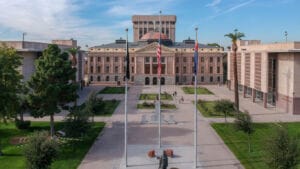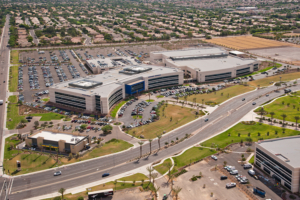NAIOP Roundtable 2011
The commercial real estate industry is clearly recovering. Companies are absorbing vacant space, build-to-suit development is active and abundant capital is pursuing core real estate. The key question remains, however, how do we compare with the other major markets when it comes to job and population growth?
In short, when will the market justify new development and how will the state and our local commercial real estate industry assist in this effort? To be sure, the future remains bright in Arizona but the recovery will last longer before the next boom.— Mike Haenel
Q: What is different in July 2011 in our local commercial real estate industry than a year ago?
BM: The short answer is that the market is stronger, but still burdened by vacancy rates that are high by historical standards, despite being lower than recent peaks. What is decidedly different, however, is that the outlook is considerably brighter than it was a year ago.
Last year at this time, uncertainty was the overriding theme and it plagued the market. The industrial market had posted just one quarter of positive absorption, and it was unclear whether that was a one-time burst in activity or a sign that tenants were more optimistic and the industrial market was beginning to turn a corner. Now we can see that tenant demand for industrial space has been sustained for more than a year, vacancy is tightening, and rents are stabilizing. We are also seeing headline-making announcements from companies such as Amazon and First Solar that not only improve the numbers, but also renew confidence in the market as a whole.
The office market has been slower to bounce back, but it is far more stable today than it was a year ago. A year ago, we were averaging negative net absorption of more than 500,000 SF per quarter, and the vacancy rate was shooting higher. While absorption has been mixed in recent quarters — up one quarter, down the next — the overall vacancy trend is essentially flat. The market hasn’t necessarily started to improve, but it’s no longer in free fall. We’re forecasting slightly positive absorption in the second half of 2011 and then positive absorption of nearly 1 MSF in 2012. We think rents will likely tick lower through the remainder of this year, because the high availability of space will continue to create competition in the marketplace.
MC: Activity is up, but it is still the quintessential “tale of two tenants.” National companies with 200,000 SF+ warehouse requirements are in the market. And, there are definitely more of those types of requirements (including build-to-suits) in the market today than there were last year at this time.
When looking, however, at say deals in the 5,000 SF to 20,000 SF range, there has been an increase in activity, but the regional and local tenants who comprise a large portion of that market segment are still facing a lot of challenges, such as difficulty obtaining financing, and economic uncertainty. These challenges result in a constraint on their ability to expand and the lack of confidence needed to make long term real estate decisions, which is why we are still seeing a number of these tenants in the smaller size ranges wanting only short-term extensions in their current spaces.
TH: I sense that we are now a local real estate industry made up of survivors. The attrition of firms is over for the most part. Those remaining have right sized for this “new normal” that we find ourselves in. Companies in our business have had to make changes in their business plans and doing activities that they did not anticipate 4 to 5 years ago. I think that this transformation has completed where a year ago it was still finding itself.
Q: How would you compare our Metro Phoenix commercial real state market to other major markets throughout the Western U.S.?
BM: At present, the characteristic that best describes the Phoenix commercial real estate market is the vacancy rate, which is among the highest, if not the highest of the major markets in the Western U.S. In the period immediately preceding the recession, development in Phoenix was fairly active, and when the economy cratered and companies slashed payrolls, there was a significant supply/demand imbalance.
The difference between Phoenix and the major California markets — where employment losses were nearly as dramatic as losses here — is that those markets didn’t have nearly as much speculative construction in the pipeline. As a result, vacancies rose in California, but not to the heights that they rose in Phoenix.
The other state that makes for an interesting comparison is Texas, where development has historically been quite active — just like Phoenix. The primary difference between Phoenix and the major Texas markets in the recession and thus far in the recovery is that the Texas markets weren’t hit nearly as hard by job losses during the downturn and the state has led the way with job gains during the recovery.
Looking ahead, the picture brightens significantly. Most forecasts call for Phoenix to rebound favorably once the economic recovery really gains traction nationally. Long-term forecasts call for annual population and employment gains in the 2.5% range, which should be similar to the major Texas markets and far outpace the California markets. This anticipated expansion is the primary source of optimism in the Phoenix market — now we’re just waiting for it to happen.
CW: The Metro Phoenix commercial real estate market has actually fared no worse or better than the other major Western U.S. markets. Retail and office continue to struggle in most markets while industrial vacancies for building over 500,000 SF have started to decrease. Recently a 500,000 SF speculative building broke ground in the Inland Empire and I believe if the economy stays as is we will see a speculative industrial building in Phoenix breaking ground by 3Q 2012. Where the Phoenix market differs from the rest of the Western U.S., with the exception of Las Vegas, is the residential real estate market. Metro Phoenix was too dependent on the residential construction market for creating jobs.
The reason this is so important until we create new jobs to replace these lost jobs, the retail and office sectors will continue to be slow to recover. People have to have a job, which allows them to have diposable income to spend at stores creating a need for new retailers. The same can be said for the office market. Until new companies locate to Metro Phoenix or are created here the need for office space will remain depressed. Most activity we are seeing in the office market are new investors coming to Metro Phoenix and buying distressed properties at a discount. This allows them to quote reduced rents forcing a downward pressure on existing landlords, who must rent space at a loss or lose a tenant. Office markets in some cities that have a more diverse economic base are recovering at a better pace than Metro Phoenix.
MC: While there has been increased activity across the Western U.S., the divergence is in the stage of recovery in primary markets such as the Inland Empire, vs. secondary markets like Phoenix.
The Inland Empire, for example, is one of the strongest industrial markets in the country with vacancy at 6.3%, which is the lowest vacancy rate in 14 quarters. By comparison, Phoenix’s Q2 2011 industrial vacancy rate was 13.9%, which was our 5th consecutive quarterly decline. But, I would say that the steady decline in vacancy we are experiencing here in Phoenix is a positive indicator, and it is only a matter of time before our recovery picks up speed.





